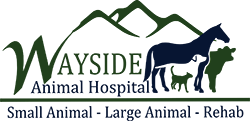Helpful Links
Wayside Animal Hospital
Dental Care Plan
Comprehensive Dental Package
Our Comprehensive Dental Package includes the following: Complete Oral Exam, Dental Cleaning, Anesthesia, a 24 hour pain injection, Dental radiographs, IV catheter with fluids and pain medication to go home if needed.
During the cleaning excessive tartar is removed from the teeth and the teeth are polished. During the procedure, the gums are also probed to detect any deep pockets around the base of the teeth, which can contribute to eventual tooth loss.
The dental radiographs help the doctor detect any issues that we are not able to see below the gum line such as bone loss and the best course of tooth removal if necessary.
The IV catheter and fluids allow us to keep our pet’s blood pressure and body temperature regulated while under anesthesia. A catheter is placed in a front leg, before anesthetic medications are given to the patient. This helps to insure a direct route for emergency drugs in case there are any complications, such as slow heart rate, while under anesthesia. We will have to shave a small portion on the leg to place the catheter.
Pre-Anesthetic Blood Work
Pets under 7 years of age (Recommended)
Pets 7 years of age and older (Required)
We require senior patients (those 7 years and older) that have not had blood work done in the past six months to have pre-anesthetic blood work. This checks liver and kidney function as well as a complete blood count and allows us to see if they will be able to process anesthesia properly. Blood work is recommended for younger patients as well but is not required.
Extraction Time
Teeth with severe fracture, abscesses, excessive bone loss, or resorptive lesions (cats) will need to be extracted. It is not uncommon to have teeth that need to be extracted, especially in small breed dogs, some cats, and pets who have not had a dental cleaning in over a year. Pets with severe dental disease or cats with stomatitis can have extraction times up to two hours.
Estimated Extractions by Grade of Dental Disease*
Grade 1: Usually no extractions
Grade 2: Average 2 extractions and up to 15 minutes; however can range from 0-14 teeth extracted with extraction time of up to 1 hour
Grade 3: Average 10 extractions and up to 45 minutes; however can range from 1-23 teeth extracted with extraction time of 15 minutes to 1 hour.
Grade 4: Average 15 extractions and up to 60 minutes; however can range from 6-42 teeth extracted with extraction time of 15 minutes to 2 hours.
*These are estimated extraction times and each pet may vary with their own individual needs.
INTRODUCTION TO GOAT LABOR
Preparing For Kidding
Kidding may occur on pasture, or you may need to provide does with a clean, dry, well-ventilated shelter, depending on the weather in your area and your preference. It is wise to watch animals carefully, in case they should require assistance. Straw or pine shavings, or an inexpensive hay, can be used for bedding in shelters, if desired. Pregnant animals will get an enlarged udder starting one to six weeks prior to kidding. Some signs that parturition, or kidding, is approaching include:
hollowness on either side of the doe’s tail
the doe isolating herself from the rest of the herd
an enlarged udder and teats that begin to fill with milk.
At two weeks prior to kidding, the muscles of the ligaments on both sides of the doe will begin to soften and relax. During the last three to four days before labor, the udder will appear quite large as it fills with milk. Does that kid for the first time may not show this development until two weeks or more after kidding. One to two days before labor, the teats become enlarged and look full of milk; the does will begin to show signs of nervousness: pawing at the ground, acting restless, and lying down. The doe will also expel a thin mucous discharge from the vulva, which will gradually become thicker as parturition approaches. The last 12 hours of labor may consist of continuous bleating sounds by the doe. The tail may be straight out or slightly elevated. The first several vertebrae of the spine in front of the tail head may appear to stand higher and taller than usual. A normal delivery usually takes five hours. Cervix dilation (which you cannot see) usually requires four hours, and then one hour is required for the delivery of the offspring. The kid should be right side up with the front feet first, with legs extended and the head lying between the knees and pasterns in a “diving” position. After the water sac breaks, the doe should start to give birth within 30 minutes to
one hour. If the doe is pushing very hard for longer than 30 minutes and a water sac or kid does not appear, it may be necessary to assist the doe yourself or contact a veterinarian for further assistance.
Generally, if the doe is still in active labor and is pushing after having a kid and does not pass placenta or another kid within 30 minutes to one hour, assistance may be needed. Some does may take longer between kids without problems. If they are up cleaning a kid and appear comfortable, longer than one hour may be acceptable. Goats may have three, or rarely, more kids. The process will repeat with each kid. When the kid is born, try to let the cord break naturally, but if the sac is not broken, break it for the doe. Newborn kids are stimulated by the doe licking it clean. Normally, kids begin to vocalize as the doe cleans them. Normal kids attempt to stand within a few hours after birth and look for the udder to nurse. Respiration in the kid is stimulated by the doe licking the kid. If the kid appears lifeless, vigorously rub the kid with a towel to stimulate respiration and clean out the mucus from the nose and mouth with a finger or soft cloth. Placing a piece of straw up the nose, which will trigger a sneezing reaction, can also help clear the airways. If the kid is still having problems, giving it short, firm, but
gentle, compressions with the fingers in the middle of the heart until it cries may help. Once the doe has kidded, make sure she has shed her placenta. Contact your veterinarian if the placenta has not detached after 12 to 18 hours.
Difficult Births (Dystocia)
Normal presentation of the kid is two front legs and nose forward in a diving position. If there is any variation in the presentation of the kid, then the delivery will not be normal.
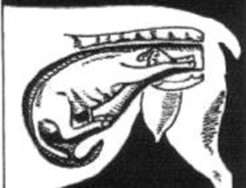
Normal kidding position
Abnormal presentations include a kid position that is fully breached, with the buttocks or back feet appearing first. If the back feet appear first, no assistance is needed. If the buttocks/tail is presented, the kid can be pushed back some, the back feet can be eased up into the position shown below (protect the uterus from puncture of feet using your hand), and kidding can be assisted if needed after that. A person assisting the doe should trim his or her nails, remove all jewelry (rings), and put on latex gloves or thoroughly wash his or her hands. Antibiotics may be needed for does that have been given assistance, depending upon the severity of the problem.
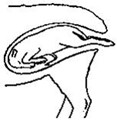
Breach kidding position
Another abnormal position may include the head presenting itself, with one foot visible, and the doe
straining unproductively. See below for additional breached positions:
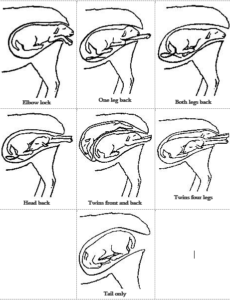
Care around the time of birth (neonatal care)
After birth, clean the mucus away from the nose, mouth, and throat. Weigh the kid, tag the ear, and dip the navel cord in 7-percent iodine to prevent navel joint disease. Make sure each kid receives its mother’s first milk (colostrum) within the first 24 hours after birth (within the first one to four hours is best). The first milk is rich in antibodies that helps the kid fight diseases. The sooner the kid nurses, the more antibodies the animal can absorb. After 24 hours, the kid’s ability to absorb antibodies from the colostrum is minimal, and shortly after that, none can be absorbed. In the case of orphans, provide colostrum from another doe that has just given birth, keep frozen colostrum on hand, or use a good colostrum replacer or supplement. Efforts can also be made to force a doe that has given birth to a single kid to adopt an orphan.
The adoption process between animals may not be as easy as it seems. First, try isolating the adopting parent in a small pen with the orphan. Hold or securely tie the doe, allowing the kid to nurse the doe several times during the day, or use a type of grafting gate, available commercially at several equipment websites (or make your own). Sometimes, using a smelly menthol-type rub in the doe’s nose, on each kid’s face, rump, and belly can make all the kids smell the same. Hopefully, after seven to 10 days of the kid(s) nursing the doe, she will think the kid(s) is hers and decide to keep it as her own. If this process does not work, stick with bottle feeding. If there are several orphans, a kid milk feeder can service up to 10 orphan kids at one time. In goats, neonatal deaths usually occur when the doe is in poor condition during the last third of pregnancy (50 days) and the kids receive inadequate consumption of colostrum during the first six
hours of life. Neonatal deaths are also higher during extreme weather conditions.
For more information about kid care, see: Kidding Management or Keeping Your Goats Healthy. Kid care after birth (post-natal care) Kids should be provided solid food within the first three weeks of life to stimulate the rumen development, and for early weaning and forage consumption. Provide feed with at least 16 percent crude protein-free choice. Some producers do not creep feed because of the inconvenience or added expense. Because mothers need extra feed for lactation, if the feeder is low enough for kids to eat, some mothers will let the kids share their food.
At six weeks of age, and again three to four weeks later (as per vaccine label), give the kids a Clostridium perfringens vaccine and tetanus vaccine (toxoid), also known as CDT. If wethers are to be sold, castrate them by at least 45 days old. Don’t wait too long to castrate males because it may be more painful to the animal and there may be greater chances for infection, especially if open castration procedures are done. If the males are not castrated, wean them and remove them from the females before they reach four months of age to prevent accidental pregnancies.
INTRODUCTION TO GOAT HERD HEALTH:
BY DR KELLY FLANAGAN
VACCINATIONS
Annual vaccines help prevent the development of series disease in your herd. The vaccine commonly known as “CDT” or “CD&T” is a vaccination for Clostridium perfringens type C + D and tetanus. The cost of vaccinating is minor compared with treating the disease or paying to replace a loved one in your herd. Please ask call us for more information on creating an annual schedule for your herd. Additional vaccines are optional for prevention of Rabies, Caseous lymphadenitis, and Pneumonia.

BASIC MAINTENANCE
Hoof trimming is as needed every 3 to 6 months. This can be needed in shorter intervals if we had a heavy rainfall. Veterinary exams should be at least once a year. At Wayside Animal Hospital, our doctor will provide an overall health assessment including FAMANCHA Scoring, rumen function, body condition, and
more!
NUTRITION
Goats are a browsing species; they have a very wide appetite for good things and bad things! They are not good “lawn mowers” as they are sometimes advertised to be. A recommended diet is grass hay (such as coastal or timothy) at 2% of body weight in pounds per day. For example, 1 lb hay would supply a 50 lbs animal. Legumes (such as alfalfa or peanut hay) can be fed in moderation. It is best to feed hay off the ground in slow feeder hay nets/hay feeders as this will limit hay wasting. Hay wasting (hay left on the ground or on stall floors) can grow mold and intestinal parasites. Please limit or feed no grain to mature pets (avoid “all stock grain or cattle feed” titles). It is highly recommended to avoid a high portion of alfalfa for castrated males (whethers) as this can increase likelihood for urinary stones. Treats are acceptable on a limited basis. Goats can become obese very quickly. Timothy hay pellets are the safest things to feed as treats. When looking for a vitamin/mineral supplement, look for a species-specific only type (“Goat/caprine only”).
GASTROINTESTINAL PARASITES
There are many different types of gastrointestinal parasites. The 2 most important are Haemonchus contortus the barber pole worm, and Telodorsagia species. As adults these 2 roundworms live in the abomasum (the 4th stomach). The adult worms pass eggs that are passed out in the feces into the grass. In the grass the eggs hatch into larvae that crawl up the grass. The animal then eats the grass with the larvae that develop into adult worms in the stomach. The whole cycle takes at least 21 days. The larvae live 3 inches from the ground on the grass, therefore, long pasture will have relatively fewer larvae than short pasture. Goats are naturally browsers and this is one of the reasons they are more susceptible to parasites compared to other species. If the weather is too hot (Summer in the South) the larvae can ‘hide’ in the wall of the stomach until conditions outside are better for development. Due to this, parasites can survive from year to year. In warm winters, and cooler summers the worms will survive in the pasture. Haemonchus worms predominantly suck blood and anemia is the main result of
infestation. Anemia can be monitored by the color of the membranes of the eye.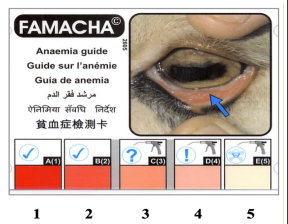
This is also called the FAMACHA method. It is recommended to perform a FAMANCHA Score every month to determine the severity of Haemonchus in your herd. Telodorsagia results in loss of protein and damages the wall causing diarrhea. Both worms will cause decreased gain, poor body condition score and weight loss. Eventually, the protein loss will result in bottle jaw, which is swelling underneath the jaw. All ages of sheep and goats are affected by parasites. Treatment of parasites is with anthelmintics (dewormers). There are 3 major groups of dewormers, avermectins (ivermectin/Ivomec, moxidectin/Cydectin) which are the clear dewormers; white dewormers (fenbendazole/Panacur and albendazole/Valbazen); and levamisole (Prohibit) and morantel (Goat dewormer pellet). Treatment should always be initially with a labelled drug. A labelled drug will state the species, dose, the route of
treatment (oral, pour on or injectable) and the withdrawal times. The withdrawal times are there to protect food safety.
The following recommendations are some general ways to prevent resistance. A parasite control plan should always be tailored to your animals and climate, and the dewormers that work best in your area.
- Weigh the animals so they get the correct dose
- Deworm base on FAMANCHA Score (Grades 3, 4, or 5)
- Deworm in addition with eggs per gram results (McMasters Fecal Egg Count)
a. This can be obtained through fecal samples and diagnostic testing with our hospital.
HERD HEALTH DISEASE PREVENTION
Caprine Arthritis Encephalitis (also known as CAE) is a virus that can cause degenerative joint changes (arthritis), firm mammary glands, inability to maintain weight, and loss of production ability in adults. In kids, this virus can cause an encephalitis (inflammation of the brain). It is most commonly transmitted through colostrum from dam (mother) to kid (child). Annual testing is recommended in herds (AGID and cELISA). All kids of positive dams should be raised on a prevention program (heat treatment of colostrum of negative CAE dams). Once a herd is negative, prevent introduction of a positive animal. Always isolate new animals for several weeks prior to introduction.
Caseous Lymphadenitis (also known as CL) is the most common bacterial infection in both sheep and goat. The organism is Corynebacterium pseudotuberculosis. It most commonly presents as an abscess (mass) in the lymph nodes of the head, neck, and shoulder. They start as firm swellings that get soft and ripen with time (will open if not lanced). Internal abscesses can also occur located in the abdomen and thorax (displaying common signs of chronic weight loss and systemic disease). When an external abscess is seen, there is a significant risk of internal abscesses. It is a highly infective organism that can
be transmitted through inhalation, ingestion or crossed skin (open wound). Water troughs, feedbunks etc can open these abscesses and increase the likelihood of other herd mates to become infected through ingestion. Paired titers are best for diagnosis (blood samples would be collected two weeks apart). Treatments with antibiotics have been used with limited success. Control of CL of a noninfected herd requires isolating new animals, culling animals that develop CL. Once a herd infected, controlling CL requires isolation of affected animals and raising kids on CAE prevention program.
TOXIC PLANTS
Common toxic plants to goats in this area of Georgia are: Azalea, Rhododendron, Laurel, Milkweed, Oleander, Nightshade, Perilla Mint, Crotalaria, Marijuana. There are many others that can cause illness. This is a basic list of common plants found in Georgia.
COMMON VETERINARY CARE
Please call our hospital for an appointment.
1. Diarrhea
2. Weight loss
3. Pink eye problems
4. Coughing, nasal discharge
5. Lumps especially in the areas of lymph nodes (neck, front shoulder, sides of hindquarters)
6. Lameness
7. Hair loss, excessive itching
8. Swollen red mammary gland(s)
EMERGENCY SITUATIONS
Please CALL immediately if any of the following are seen:
Veterinary Phone Number: 706-692-2210
1. Dystocia: difficult birthing if no progression after straining for 30 minutes
2. Straining to urinate (MALES): males will cry out, stretch and/or stop eating. Can be deadly if not resolved.
3. Severe diarrhea (especially in younger animals)
4. Wounds/cuts needing stitching
5. Bloated stomach
6. Tissue hanging from rectum or vulva (rectal, vaginal, uterine prolapse)
7. Unable to walk
8. Pregnant animal not eating, teeth grinding, lethargic, not walking
9. Pressing head into the wall or fence
Call Us
Jasper Office: 706-692-2210
Visit Us
Jasper Office
99 Cove Road
Jasper, GA 30143
Call Us
Jasper Office: 706-692-2210
Visit Us
Jasper Office
99 Cove Road
Jasper, GA 30143
